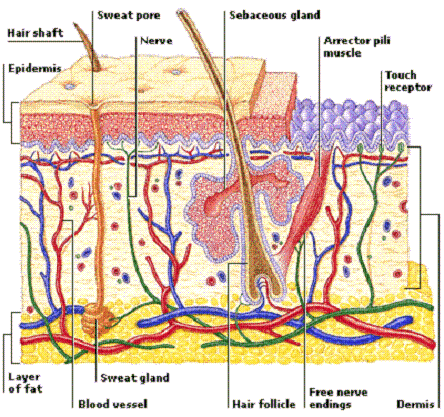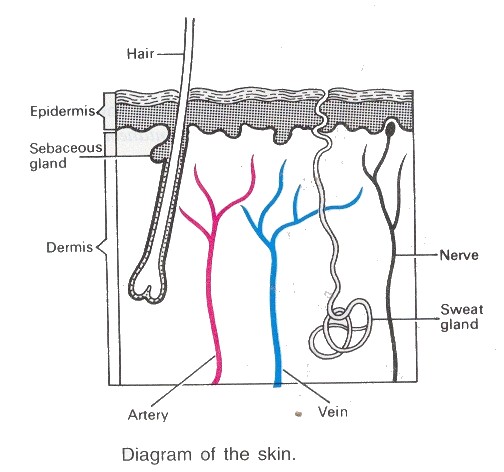The Skin
Definition
The skin is an organ that covers the entire external surface of the human body
Interacts with the surrounding world.
Protects from exposure to trauma, ultraviolet (UV) radiation, temperature extremes, toxins, and bacteria.
Other important functions : sensory perception, immunologic surveillance, thermoregulation, and control of insensible fluid loss.
Layers
Epidermis
Fatty subcutaneous layer, the panniculus adiposus
Dermis
Development
The epidermis derived from ectoderm
Has melanocytes of neural crest origin, Langerhans cells of bone marrow origin, and Merkel cells of neural crest origin.
The dermis derived from mesoderm
Has collagen, elastic fibers, blood vessels, sensory structures, and fibroblasts.
Skin undergoes continuous changes throughout life as outer layers are shed and replaced by inner layers.
Epidermal thickness is rather constant throughout life
Dermal thickness varies according to sex, location
Thickest on the palms and soles
Thinnest in the eyelids and in the postauricular region.
Male skin is thicker
Children have thin skin
With age loss of elastic fibers, epithelial appendages, and ground substance.
Epidermis
No blood vessels
Stratified squamous epithelium
Consists of keratinocyte
Layers : stratum germinativum, stratum spinosum, stratum granulosum, and stratum corneum.
Keratinocytes
Single cell layer of keratinocytes .
Keratinocytes divide and differentiate,
They become devoid of nuclei and are subsequently shed in the process of epidermal turnover.
Melanocytes
Melanocytes produce a pigment, melanin - absorbs radiant energy from the sun and protects the skin from the harmful effects of UV radiation.
Melanocytes are found in the basal layer of the epidermis as well as in hair follicles - melanoma.
Langerhans cells
Found in the basal, spinous, and granular layers of the epidermis. They serve as antigen-presenting cells. - contact hypersensitivity.
Merkel cells
Merkel cell, found on the volar aspect of digits, in nail beds, on the genitalia - perception of light touch.
Dermis
Sustains and supports the epidermis.
2 layers
Papillary dermis - thinner - has loose connective tissue - contains capillaires, elastic fibers, retucular fibers, collagen
Reticular dermis. - thicker - has dense connective tissue - contains larger blood vessels, elastic fibers,collagen fibers. fibroblasts, mast cells, nerve endings, lymphatics and epidermal appendages
Fibroblasts
Major cell type of the dermis. Produce and secrete procollagen and elastic fibers.
provide tensile strength and resistance to shear and other mechanical forces
Epidermal appendages are intradermal epithelial structures lined with epithelial cells with the potential for division and differentiation. These are important as a source of epithelial cells, which accomplish reepithelialization should the overlying epidermis be removed or destroyed in situations such as partial thickness burns, abrasions, or split-thickness skin graft harvesting.
Epidermal appendages include the following:
Sebaceous glands
Sweat glands
Apocrine glands
Mammary glands
Hair follicles
They often are found deep within the dermis and in the face may even lie in the subcutaneous fat beneath the dermis. This accounts for the remarkable ability of the face to reepithelialize even the deepest cutaneous wounds.[1]
Sebaceous glands
Sebaceous glands found over the entire surface of the body except the palms, soles, and dorsum of the feet.
Llargest and most concentrated in the face and scalp
secrete sebum.
Sweat glands
Sweat glands, or eccrine glands, found over the entire surface of the body except the vermillion border of the lips, the external ear canal, the nail beds, the labia minora, and the glans penis and the inner aspect of the prepuce. They are most concentrated in the palms and soles and the axillae.
Apocrine and mammary glands
Apocrine glands found in the axillae, in the anogenital region and in the external ear canal, eyelid (Moll's glands), and the breast (mammary glands). They produce odor and do not function prior to puberty. The mammary gland is considered a modified and highly specialized type of apocrine gland.
Hair follicles
Found over the entire surface of the body except the soles of the feet, palms, glans penis, clitoris, labia minora, mucocutaneous junction, and portions of the fingers and toes. Sebaceous glands often open into the hair follicle




